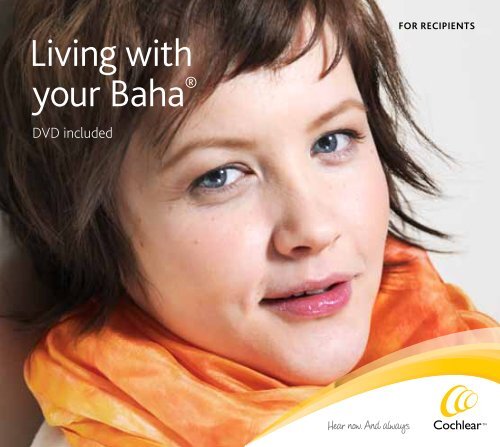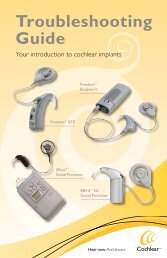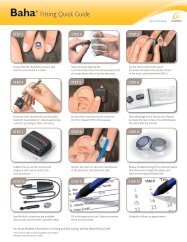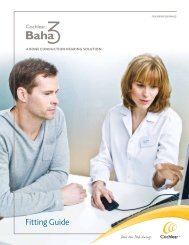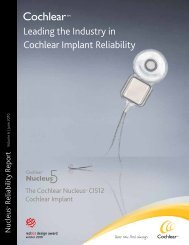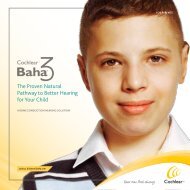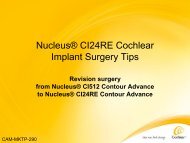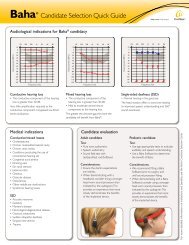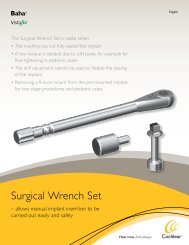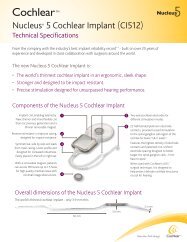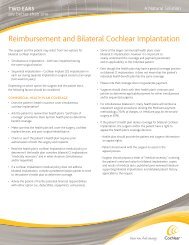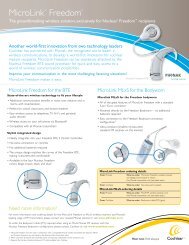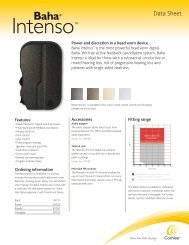Living with your Baha® - Cochlear
Living with your Baha® - Cochlear
Living with your Baha® - Cochlear
Create successful ePaper yourself
Turn your PDF publications into a flip-book with our unique Google optimized e-Paper software.
<strong>Living</strong> <strong>with</strong><br />
<strong>your</strong> Baha ®<br />
DVD included<br />
For recipients<br />
1
Contents<br />
5 How to look after <strong>your</strong> Baha ® – and <strong>your</strong>self!<br />
6 After surgery<br />
6 Daily cleaning<br />
7 Weekly cleaning<br />
8 Attaching and removing <strong>your</strong> sound processor<br />
9 Protecting <strong>your</strong> abutment<br />
9 Attaching a safety line<br />
10 Baha and children<br />
10 What is a Baha Softband?<br />
12 Twelve golden rules for handling <strong>your</strong> Baha sound processor<br />
14 Using phones and other accessories<br />
16 Quick guides to the sound processors<br />
21 What to expect from <strong>your</strong> batteries<br />
22 Troubleshooting<br />
24 Aftercare Kit<br />
25 About the DVD<br />
26 How to look after <strong>your</strong> Baha – Quick Guide<br />
2 3
How to look after <strong>your</strong> Baha ®<br />
– and <strong>your</strong>self!<br />
Your Baha ® sound processor is a sophisticated hearing<br />
system full of delicate microelectronic components, so<br />
you must take care of it – and <strong>your</strong>self!<br />
This brochure shows you what to do after the surgery and how to keep<br />
<strong>your</strong> Baha sound processor and the abutment in prime condition. The<br />
procedures outlined both here and in the accompanying DVD are so<br />
easy to follow, that they’ll soon become part of <strong>your</strong> daily routine.<br />
And the rewards will be well worth the effort! With a Baha system<br />
you’ll be able to hear and communicate <strong>with</strong> ease.<br />
4 5
After surgery<br />
For the best result, you need to take care of the abutment to avoid<br />
any complications <strong>with</strong> the surrounding tissue. If the area has healed,<br />
the dressing and stitches will be removed 10–14 days after surgery. If<br />
not, the dressing may have to stay in place longer.<br />
At home it is important to maintain good daily hygiene; for the<br />
first few weeks after the dressing has been removed, wash <strong>your</strong> hair<br />
carefully and use a strip of alcohol-free wet wipe to keep the skin<br />
around the abutment clean.<br />
Daily cleaning<br />
After the first few weeks you can start cleaning the outside of the<br />
abutment <strong>with</strong> the soft abutment cleaning brush provided. Aim the<br />
bristles at the side of the abutment, and remove any debris that might<br />
have built up around the base. You can do this while taking a bath or<br />
shower, using mild soap and plenty of warm water. When you have<br />
finished bathing, use a strip of alcohol-free wet wipe to make sure<br />
that all debris has been removed.<br />
Weekly cleaning<br />
Clean the inside of the abutment every week, <strong>with</strong> the abutment<br />
cleaning brush, as debris can also build up there.<br />
If you should experience soreness or inflammation, or if the abutment<br />
feels loose, contact <strong>your</strong> clinician or hearing care center. Otherwise,<br />
it’s a good idea to get checkups regularly.<br />
remember:<br />
• Always rinse the abutment<br />
cleaning brush in mild soap<br />
and warm water and let it<br />
air dry. Change the brush<br />
every three months, or if<br />
you have had an infection.<br />
• If you have bilateral<br />
implants, use two separate<br />
cleaning brushes (one for<br />
each abutment), to avoid<br />
cross-contamination.<br />
• You can get new cleaning<br />
brushes from <strong>your</strong> hearing<br />
care center or order them<br />
from www.cochlear.com.<br />
6 7
Attaching and removing<br />
<strong>your</strong> sound processor<br />
Your Baha sound processor is designed to snap onto the abutment.<br />
Simply attach it at a slight angle and tilt or rock it into place, taking<br />
care to keep <strong>your</strong> hair out of the way. The tilt technique reduces the<br />
pressure on the abutment and prevents any discomfort. Make sure<br />
you never push the sound processor straight in.<br />
To remove the sound processor again, lift <strong>your</strong> hair, slide a fingertip<br />
under it, and gently tilt it until it snaps off. Never pull it straight out.<br />
Protecting <strong>your</strong> abutment<br />
Whenever you are not wearing <strong>your</strong> Baha sound processor, you can<br />
protect the abutment using the press-on abutment cover provided<br />
<strong>with</strong> <strong>your</strong> sound processor. Wear it when sleeping, and when<br />
having hair treatments. During rough contact sports you can wear a<br />
sweatband over the abutment for additional protection.<br />
Attaching a safety line<br />
When taking part in activities where you risk losing <strong>your</strong> sound<br />
processor we recommend using the safety line provided. Insert the<br />
line into the attachment point and fasten it to <strong>your</strong> clothing.<br />
Note: The safety line should always be used when a Baha sound<br />
processor is worn by children.<br />
8 9
Baha and children<br />
Children who use a Baha system need to observe the same routines<br />
as adults. Their parents/caregivers should teach them how to keep the<br />
abutment clean and the skin around it healthy. They should also be<br />
taught the importance of keeping their Baha sound processor safe –<br />
including using a safety line to avoid losing it.<br />
Note: In the US, the Baha implant is indicated for children aged five<br />
years and older.<br />
What is a Baha ® Softband?<br />
Until children are ready for an implant they can wear their Baha sound<br />
processor on a colorful Baha Softband. This consists of an elastic headband<br />
<strong>with</strong> a plastic snap connector that holds the sound processor in place.<br />
To avoid any sore areas, this adjustable band can be turned, so the sound<br />
processor is not always in the same position. The Baha Softband enables<br />
a variety of listening opportunities. For example, in a car seat the sound<br />
processor can be worn on the forehead to maximize sound perception.<br />
Note: The Baha Softband contains natural rubber latex that might<br />
cause allergic reactions.<br />
10 11
Twelve golden rules<br />
for handling <strong>your</strong> Baha ® sound processor<br />
Your Baha sound processor contains very delicate components, so<br />
you should handle it <strong>with</strong> care – and never drop it! Follow these<br />
golden rules to keep <strong>your</strong> sound processor safe:<br />
1. You can wear <strong>your</strong> Baha sound processor<br />
all day long – apart from when sleeping, bathing,<br />
showering, swimming or during rough contact<br />
sports.<br />
2. When adjusting <strong>your</strong> sound processor, make<br />
sure <strong>your</strong> hands are clean to avoid getting the<br />
inside or outside of the casing dirty.<br />
3. When taking part in activities where you<br />
could lose <strong>your</strong> sound processor, either remove it<br />
or use the safety line provided.<br />
4. Your Baha sound processor is NOT<br />
waterproof. Never wear it in the shower or when<br />
swimming. In rainy conditions, use an umbrella.<br />
5. If visiting or living in an area <strong>with</strong> high<br />
humidity, you can use a Dry Aid Kit (a bag or<br />
container that contains crystals that absorb residual<br />
moisture from <strong>your</strong> sound processor) to keep <strong>your</strong><br />
sound processor in good working order.<br />
6. Your Baha sound processor cannot <strong>with</strong>stand<br />
extreme temperatures. So never leave it on the<br />
dashboard in <strong>your</strong> car in bright sunlight or expose it to<br />
any other kind of extreme treatment.<br />
7. Clean the external casing of <strong>your</strong> sound<br />
processor regularly <strong>with</strong> an AudioWipe ® , and<br />
clean the snap <strong>with</strong> a small sound processor brush<br />
(both provided in the Aftercare Kit).<br />
8. When using hair products like hairspray,<br />
always cover <strong>your</strong> Baha sound processor to<br />
avoid damaging the microphone or the casing.<br />
Alternatively, remove it entirely.<br />
9. To avoid feedback (whistling), don’t let<br />
objects come too close to <strong>your</strong> Baha sound<br />
processor (e.g. a hat, hairbrush, phone, glasses etc.).<br />
10. To store <strong>your</strong> Baha sound processor safely<br />
after use, remove the battery and place the sound<br />
processor in its case.<br />
11. If you need an MRI scan, it is crucial to<br />
remove the sound processor beforehand. The<br />
implant and abutment can remain in place.*<br />
12. When travelling, remove <strong>your</strong> Baha sound<br />
processor when going through security screening<br />
to avoid setting off metal detectors in places such<br />
as airports. An MRI/Security control instructions<br />
card is included <strong>with</strong> <strong>your</strong> sound processor, which<br />
provides information for airport personnel.<br />
* Arndt S, Kromeier J, Berlis A, Maier W, Laszig R, Aschendorff A. Imaging procedures after Bone-Anchored Hearing Aid implantation.<br />
The Laryngoscope 2007:117<br />
12 13
Using phones and other accessories<br />
The best way to use telephones and cell phones <strong>with</strong> <strong>your</strong><br />
Baha sound processor is to hold the phone receiver close to the<br />
microphone inlet of <strong>your</strong> sound processor rather than close to <strong>your</strong><br />
ear. Don’t let <strong>your</strong> hand or the phone touch the sound processor, as<br />
this may cause it to whistle. When using Baha ® Cordelle II, the phone<br />
receiver should be next to the microphone on the body-worn unit.<br />
Most landline telephones are “hearing aid compatible” i.e. they have<br />
a built-in telecoil. If you are a Baha BP100, Baha Divino or Baha<br />
Intenso user, you will need to attach the Baha Telecoil accessory<br />
to <strong>your</strong> sound processor and switch to the program for external<br />
equipment. For Baha ® Cordelle II, the telecoil is built into the bodyworn<br />
unit, so all you need to do is switch to the Telecoil program.<br />
Telecoils, FM receivers, and Audio adapters are available as optional<br />
accessories for <strong>your</strong> sound processor. They are easy to order from<br />
<strong>your</strong> hearing care center or from www.cochlear.com.<br />
Note: FM receivers should be ordered from a hearing care center or<br />
the FM system manufacturer directly.<br />
FM Receivers<br />
An FM system makes listening easier in noisy environments,<br />
such as in classrooms. FM receivers can be specific in how they<br />
connect to <strong>your</strong> Baha sound processor; consult a hearing care<br />
specialist to determine the FM receiver that is best for you.<br />
Telecoil<br />
The Baha Telecoil accessory may help you hear better when using a<br />
phone or in buildings <strong>with</strong> loop facilities, such as churches, theaters,<br />
and airports. The Baha ® Cordelle II has a built-in telecoil, so no<br />
external accessory is required.<br />
Audio adapter<br />
The Audio adapter allows direct input from computers, personal<br />
stereos, TVs, MP3 players and other external equipment. Always use<br />
the audio adapter to connect <strong>your</strong> Baha sound processor to any<br />
electrical or battery-operated equipment.<br />
Only <strong>Cochlear</strong> products and accessories, or products and accessories approved by <strong>Cochlear</strong>, should be<br />
used <strong>with</strong> each other to ensure the warranty is maintained.<br />
*Choice of accessories may vary depending on <strong>your</strong> Baha sound processor model<br />
14 15<br />
*<br />
*<br />
*
Your quick guide to<br />
<strong>Cochlear</strong> Baha ® BP100<br />
u On/Off & Programme Selection Button:<br />
Use the middle button to conveniently switch on and off the BP100, and to<br />
switch between the programmes pre-set by <strong>your</strong> hearing care professional.<br />
v Volume down button<br />
Use this button to decrease the volume.<br />
w Volume up button<br />
Use this button to increase the volume.<br />
x Plastic snap connector<br />
y Attachment point for the safety line<br />
U Battery compartment door. Remove the door when changing battery.<br />
V Visual status indicators<br />
Orange for processors worn on the right side of the head<br />
Blue for processors worn on the left side of the head<br />
W Direct Audio Input: For connecting audio accessories.<br />
X Microphones<br />
Consult the Baha BP100 User Manual for more details.<br />
Note: Baha BP100 not shown in actual size<br />
u<br />
v<br />
w<br />
x<br />
y<br />
U<br />
V<br />
W<br />
X<br />
16 17<br />
v
Baha Divino ®<br />
Your quick guide to<br />
u Volume control and On/Off button: Move the wheel up to turn <strong>your</strong><br />
sound processor on and to increase the volume. To decrease the volume and<br />
to turn <strong>your</strong> sound processor off, move the wheel down.<br />
v Program switch:<br />
Program 1 puts the microphone into omni-directional mode, where it will<br />
pick up sound from a 360° radius. Ideal for quiet surroundings.<br />
Program 2 activates the directional microphone. This will prioritize sounds<br />
coming from the front rather than from behind, which makes it easier to<br />
hear speech in noise. Note that in this program the electrical input is not<br />
activated, so any connected audio accessories will be muted.<br />
w Direct Audio Input: For connecting audio accessories.<br />
x Swing-out battery door: When changing the battery, remember to remove<br />
the plastic strip and make sure the plus-mark is facing upwards. Don’t force<br />
the door shut, as it could break.<br />
Note: Never adjust the potentiometers y as this may void <strong>your</strong> warranty.<br />
Consult the Baha Divino User Manual for more detailed information. x<br />
Note: Baha Divino not shown in actual size.<br />
u<br />
v<br />
w<br />
y<br />
Your quick guide to<br />
Baha Intenso <br />
u Volume control and On/Off button: Move the wheel up to turn <strong>your</strong><br />
sound processor on and to increase the volume. To decrease the volume and<br />
to turn <strong>your</strong> sound processor off, move the wheel down.<br />
v Program switch:<br />
Program 1 is the standard setting, suitable for most everyday situations.<br />
Program 2 is a comfort setting that may be useful in certain<br />
loud, adverse listening environments.<br />
Program E can be used when listening exclusively to input<br />
from an audio accessory, or as an instant mute, because it turns off<br />
the microphone.<br />
w Direct Audio Input: For connecting audio accessories.<br />
x Sliding battery door: When changing the battery, remember to remove the<br />
plastic strip and make sure the plus-mark is facing upwards. Don’t force the<br />
door shut, as it could break. Your sound processor will emit two beeps when<br />
the battery is low and needs to be changed.<br />
Note: Never adjust the potentiometers y as this may void <strong>your</strong> warranty.<br />
Consult the Baha Intenso User Manual for more detailed information.<br />
Note: Baha Intenso not shown in actual size.<br />
18 19<br />
u<br />
v<br />
w<br />
y<br />
x
Your quick guide to<br />
Baha ® Cordelle II<br />
u Connector cable: Connect the straight plug to the head-worn unit and the<br />
angled plug to the body-worn unit.<br />
v Volume control and On/Off button: Move the wheel to turn <strong>your</strong> sound<br />
processor on or off and to increase or decrease the volume.<br />
w Tone switch: The tone switch controls the frequency response of the sound<br />
processor. It can be set in three different positions:<br />
N=Normal. Amplifies all frequencies equally.<br />
H=High frequency emphasis. Reduces low frequency sounds which may<br />
improve speech understanding, especially in background noise.<br />
L= Low frequency emphasis. May be especially useful during the first period<br />
after fitting as it allows you to gradually get used to high frequency sounds<br />
you have not heard for a long time.<br />
x Built-in telecoil<br />
y Direct Audio Input for connecting audio accessories<br />
U Program switch: M= Microphone, MT=Microphone and Telecoil, T=Telecoil<br />
V Flip-up battery cover: When changing the battery, remember to use 9V<br />
batteries only. Make sure the plus-mark on the battery is facing the plusmark<br />
on <strong>your</strong> body worn unit. Don’t force the door shut, as it could break.<br />
Note: Never adjust the potentiometers W as this may void <strong>your</strong> warranty.<br />
Consult the Baha ® Cordelle II User Manual for more detailed information.<br />
Note: Baha ® Cordelle II not shown in actual size.<br />
u<br />
v<br />
w<br />
x<br />
y<br />
U<br />
W<br />
V<br />
What to expect from <strong>your</strong> batteries<br />
Which battery to use (type 13, 675 or 9V) will depend on which Baha sound processor you are using. Just<br />
remember that for the smaller type 13 and 675 batteries, the battery will begin to drain once you remove<br />
the plastic strip – even if the sound processor is not actually in use! The batteries delivered <strong>with</strong> <strong>your</strong><br />
sound processor reflect <strong>Cochlear</strong>’s latest battery brand recommendation.<br />
There are a number of factors that affect battery life. Brand type is one factor; low temperatures and<br />
hourly use are others. The program and volume control settings – as well as the use of accessories such as<br />
FM equipment – can also affect the life of the battery. Be sure to use only new, high quality batteries as<br />
this gives the best sound performance.<br />
testing type 13 and 675 batteries<br />
To test the battery, place it in the tester (provided in <strong>your</strong> Aftercare Kit)<br />
<strong>with</strong> the plus-mark facing upwards, and press it onto the metal band. The<br />
display screen will then indicate how much power is left. The more bars<br />
there are, the more power is left in the battery.<br />
20 21
Troubleshooting<br />
If you experience physical problems or any difficulty using <strong>your</strong> Baha<br />
system, follow the guidelines listed in the chart below. If this fails to<br />
help, please contact <strong>your</strong> hearing care center for further assistance.<br />
problem cause possible solution<br />
No sound/weak<br />
sound<br />
Weak or dead battery. Replace battery.<br />
Volume too low. Turn up volume.<br />
Feedback (whistling) Hat, glasses or other object<br />
in contact <strong>with</strong> sound<br />
processor.<br />
Sound is distorted<br />
or intermittent<br />
Battery door in wrong<br />
position.<br />
Check that the sound processor is not touching<br />
anything. Relocate or remove the object.<br />
Close battery door.<br />
Too high volume. Decrease volume.<br />
Weak battery. Replace battery.<br />
Loose abutment. Contact <strong>your</strong> hearing care specialist.<br />
problem cause possible solution<br />
Sound processor<br />
does not work<br />
Both indicators<br />
flashing<br />
Redness or soreness<br />
around the<br />
abutment<br />
Sound processor is<br />
not turned on.<br />
Battery door is not<br />
completely closed.<br />
Turn on sound processor.<br />
Dead battery. Replace battery.<br />
Battery inserted wrong<br />
way.<br />
Audio accessory program<br />
active and no accessory<br />
connected.<br />
Programming mode<br />
enabled.<br />
Gently close the battery door completely.<br />
Make sure battery is inserted correctly.<br />
Check program setting.<br />
Remove and insert battery.<br />
Keep the abutment site completely clean,<br />
using the soft abutment cleaning brush and/or<br />
alcohol-free wet wipes.<br />
Apply a mild antibiotic cream/ointment<br />
(provided by clinic) if necessary.<br />
Contact <strong>your</strong> clinic or hearing care center if<br />
redness and/or soreness persists.<br />
22 23
Aftercare Kit<br />
The following items are included in the Aftercare Kit:<br />
Brochure and DVD<br />
Battery tester<br />
Mirror<br />
AudioWipes ®<br />
Single pack wipe for cleaning<br />
the sound processor.<br />
sound processor brush<br />
Black brush <strong>with</strong> hard bristles for<br />
cleaning the plastic snap.<br />
To reorder supplies please visit www.cochlear.com<br />
Alcohol-free wet wipes<br />
Pack of 10 wipes for cleaning the<br />
abutment area.<br />
Abutment cleaning brush<br />
White brush <strong>with</strong> soft bristles<br />
for cleaning the abutment area.<br />
<strong>Living</strong> <strong>with</strong> <strong>your</strong> Baha ®<br />
Baha and Baha Divino are registered trademarks, and Baha Intenso is a<br />
trademark of <strong>Cochlear</strong> Bone Anchored Solutions AB. <strong>Cochlear</strong> and the<br />
elliptical logo are trademarks of <strong>Cochlear</strong> Limited.<br />
© 2009 <strong>Cochlear</strong> Bone Anchored Solutions.<br />
All rights reserved. APR09<br />
About the DVD<br />
• Using <strong>your</strong> sound processor<br />
• Taking care of <strong>your</strong> abutment<br />
• Taking care of <strong>your</strong> sound processor<br />
• Audio accessories and telephones<br />
• Testing <strong>your</strong> sound processor<br />
• Baha ® Softband<br />
• When to visit the clinic<br />
24 25
How to look after <strong>your</strong> Baha ®<br />
Place the sticker below on <strong>your</strong> bathroom mirror as a reminder<br />
to maintain good daily hygiene for the abutment, skin in the<br />
surrounding tissue area and sound processor.<br />
1. After surgery,<br />
use a strip of<br />
alcohol-free wet<br />
wipe to keep the<br />
skin around the<br />
abutment clean.<br />
2. Clean the<br />
outside of the<br />
abutment <strong>with</strong> the<br />
abutment cleaning<br />
brush daily.<br />
3. Clean the<br />
inside of the<br />
abutment <strong>with</strong> the<br />
abutment cleaning<br />
brush weekly.<br />
4. Wipe the<br />
sound processor<br />
using an alcoholfree<br />
AudioWipe®.<br />
5. Clean the snap<br />
connector using<br />
the black sound<br />
processor brush.<br />
<strong>Living</strong> <strong>with</strong> <strong>your</strong> Baha ®<br />
Baha and Baha Divino are registered trademarks, and Baha Intenso is a<br />
trademark of <strong>Cochlear</strong> Bone Anchored Solutions AB. <strong>Cochlear</strong> and the<br />
elliptical logo are trademarks of <strong>Cochlear</strong> Limited.<br />
© 2009 <strong>Cochlear</strong> Bone Anchored Solutions.<br />
All rights reserved. JUL09<br />
26 27
Manufacturer:<br />
<strong>Cochlear</strong> Bone Anchored Solutions AB Konstruktionsvägen 14, SE-435 33 Mölnlycke, Sweden Tel: +46 31 792 44 00 Fax: +46 31 792 46 95<br />
regional offices:<br />
<strong>Cochlear</strong> Americas 13059 E. Peakview Avenue, Centennial, CO 80111, USA Tel: +1 303 790 9010 Fax: +1 303 792 9025<br />
<strong>Cochlear</strong> AG European Headquarters, Peter Merian-Weg 4, CH-4052 Basel, Switzerland Tel: +41 61 205 0404 Fax: +41 61 205 0405<br />
<strong>Cochlear</strong> Ltd (ABN 96 002 618 073) 14 Mars Road, Lane Cove NSW 2066, Australia Tel: +61 2 9428 6555 Fax: +61 2 9428 6352<br />
Local offices:<br />
<strong>Cochlear</strong> Benelux NV Schaliënhoevedreef 20 i, B-2800 Mechelen, Belgium Tel: +32 15 79 55 77 Fax: +32 15 79 55 70<br />
<strong>Cochlear</strong> Canada Inc 2500-120 Adelaide Street West, Toronto, ON M5H 1T1, Canada Tel: +1 416 972 5082 Fax: +1 416 972 5083<br />
<strong>Cochlear</strong> (HK) Ltd Beijing Representative Office, Unit 2205 - 2207, Tower B, 91 Jianguo Road, Chaoyang District, Beijing 1000022<br />
P.R. China Tel: +86 10 8599 9924 Fax: +86 10 8599 9804<br />
<strong>Cochlear</strong> France S.A.S. Route de l'Orme aux Merisiers, Z.I. Les Algorithmes - Bât Homère, F-91190 St Aubin,<br />
France Tel: +33 811 111 993 Fax: +33 160 196 499<br />
<strong>Cochlear</strong> Deutschland GmbH & Co. KG Karl-Wiechert-Allee 76A, D-30625 Hannover, Germany Tel: +49 511 542 770 Fax: +49 511 542 7770<br />
<strong>Cochlear</strong> (HK) Ltd Room 1810, Hopewell Centre, 183 Queen's Road East, Wan Chai, Hong Kong Tel: +852 2530 5773 Fax: +852 2530 5183<br />
<strong>Cochlear</strong> Italia SRL Via Augusto Murri, 45/L, I-40137 Bologna, Italy Tel: +39 051 741 9811 Fax: +39 051 392 062<br />
Nihon <strong>Cochlear</strong> Co Ltd Ochanomizu-Motomachi Bldg, 2-3-7 Hongo, Bunkyo-Ku, Tokyo 113-0033, Japan Tel: +81 3 3817 0241 Fax: +81 3 3817 0245<br />
<strong>Cochlear</strong> Korea Ltd 5F, Seong San BD, 1689-5, Seocho-dong, Seocho-gu, Seoul, Korea Tel: +82 2 533 4450 Fax: +82 2 533 8408<br />
<strong>Cochlear</strong> Ltd (Singapore Branch), 6 Sin Ming Road, #01-16 Sin Ming Plaza Tower 2, Singapore 575585 Tel: +65 6553 3814 Fax: +65 6451 4105<br />
<strong>Cochlear</strong> Nordic AB Konstruktionsvägen 14, SE-435 33 Mölnlycke, Sweden Tel: +46 31 335 14 61 Fax: +46 31 335 14 60<br />
<strong>Cochlear</strong> Tıbbi Cihazlar ve Sağlık Hizmetleri Ltd. Sti., Cubuklu Mah. Bogazici Cad., Bogazici Plaza No:6/1, Kavacik<br />
34805 Beykoz-Istanbul, Turkey Tel: +90 216 538 5900 Fax: +90 216 538 5919<br />
<strong>Cochlear</strong> Europe Ltd 9 Weybridge Business Park, Addlestone Road, Addlestone, Surrey KT15 2UF,<br />
United Kingdom Tel: +44 1932 87 1500 Fax: +44 1932 87 1526<br />
www.cochlear.com<br />
Baha and Baha Divino are registered trademarks, and Baha Intenso is a trademark of <strong>Cochlear</strong> Bone Anchored<br />
Solutions AB. <strong>Cochlear</strong> and the elliptical logo are trademarks of <strong>Cochlear</strong> Limited. AudioWipes is a registered<br />
trademark of Oaktree Products Inc. © 2009 <strong>Cochlear</strong> Bone Anchored Solutions. All rights reserved.<br />
JUN09. Printed in Sweden. E81254A


